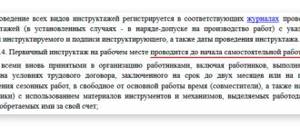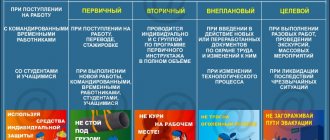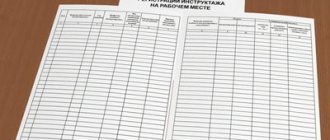The legislative framework
Today in the Russian Federation there are several legal acts that regulate processes related to injuries at work:
- Resolutions of the Ministry of Labor establishing processes related to the registration of acts in the event of an employee being injured at work;
- The Constitution of the Russian Federation, according to which each employee must be provided with appropriate working conditions;
- Labor Code regulating the preparation and execution of a package of documents required in case of an industrial injury
The main differences between a civil contract and an employment contract
- The employment contract indicates that the contractor’s employee performs work in a certain specialty, qualification or position. The civil contract specifies only the nature of the work and the expected result.
- According to the employment contract, work is performed only by the contractor personally, and the employee is subject to internal labor regulations. In a civil contract, the contractor can perform the work either personally or delegate it to a subcontractor. At the same time, he does not obey the internal rules of the customer.
- Payment under an employment contract occurs at least every half month. In a work contract, payment is also possible in installments, but only after a certain stage of work has been completed and an acceptance certificate has been issued.
The final decision regarding the registration of the incident will depend on the court order. Moreover, if the contract is recognized as an employment contract, the employer may be fined in the amount of 30,000 to 50,000 rubles (Part 1 of Article 5.27 of the Code of Administrative Offenses of the Russian Federation). And from January 1, 2015, fines will increase further: the fine for an organization will be from 50,000 to 100,000 rubles (Part 3 of Article 5.27.1 of the Code of Administrative Offenses of the Russian Federation).
When to investigate
According to current legislation, an investigation is required if the following has been recorded:
- receiving physical injury or injury;
- electric shock or lightning;
- drowning;
- frostbite;
- burn;
- fainting;
- injury as a result of an explosion or collapse of buildings;
In order for injuries and injuries to be classified as work-related, they must occur under the following circumstances:
- on the territory of the enterprise, during lunch or during the immediate work shift;
- while traveling to or from the place of work on official transport or on your own, if this has been agreed in advance with management;
- while on an official business trip;
- while performing work on a rotational basis.
There are other circumstances in which an injury is considered work-related.
Investigation Process
If it is determined that an employee of the enterprise was injured in the workplace at a production facility, then the employer is responsible for organizing a work group. She will be tasked with conducting an investigation and clarifying the circumstances of the incident. The composition of such a commission must include at least three officials:
- an employee who is an official representative of the employer. As a replacement, the commission may include a representative of government agencies that control such procedures;
- trade union representative;
- an official whose responsibilities include monitoring compliance with safety requirements at the facility.
If two or more employees were injured as a result of an accident, or a fatality occurred as a result of the incident, then a commission with an expanded composition is organized. The regular commission is joined by:
- government inspector;
- a person representing the local district administration;
- authorized representative of the trade union organization of the region in whose territory the industrial accident occurred.
If as a result of an accident the number of workers injured is more than 5, then the following must additionally participate in the commission:
- authorized employee of the State Inspectorate;
- representative of a trade union at the all-Russian level.
The victim himself has the right to participate in any commission. This possibility is assigned to it at the legislative level and allows one to avoid data falsification.
EMPLOYEE COMPLAINTS
A fine of 85 thousand rubles was imposed on the Nizhny Novgorod McDonald's restaurant for violating labor standards
The distribution of workwear and footwear in the company is carried out improperly.
Nizhny Novgorod. 05 July. NewsNN.ru. The State Labor Inspectorate in the Nizhny Novgorod Region fined the fast food restaurant McDonald's LLC 80 thousand rubles, and the director of the establishment 5 thousand rubles for violating labor laws. This is stated in a press release from the department.
An inspection carried out following a complaint from a restaurant employee discovered violations of labor protection in terms of providing workers with personal protective equipment (for example, overalls and shoes). The issuance of these protective equipment is not properly recorded.
The State Labor Inspectorate issued an order to the company to eliminate the detected violations by July 14, 2021. As stated in the materials on the website of the Nizhny Novgorod administration, the turnover of public catering in the city in May amounted to 1.7 billion rubles, which is almost twice as much as in April 2021 and 27% more than the level of May 2015 in current prices. According to the McDonald's website, there are seven restaurants of this chain in Nizhny Novgorod, and one more each in Kstovo and Dzerzhinsk.
The director of a logging organization in the Khabarovsk Territory was punished at the request of workers
The director of the logging organization "Forest Resources" was fined 373 thousand rubles, the Gubernia portal reports, citing the press service of the prosecutor's office of the Khabarovsk Territory. This amount also includes fines issued to the company as a legal entity.
A comprehensive inspection of Forest Resources was carried out after the company’s employees filed complaints with the prosecutor’s office of the Vaninsky district. State service employees identified a number of violations in the field of labor protection. Thus, the enterprise does not conduct periodic medical examinations, and the building is not equipped with an automatic fire alarm.
Currently, ten cases of administrative offenses have been initiated against the director and legal entity “Forest Resources”.
Registration of acts
If an employee of an enterprise or other production facility is injured, then it is necessary to draw up an appropriate report. All information contained in it is written in Russian. If the injured person is a citizen of another state, then a similar act is drawn up in his native language. The number of such documents will be calculated based on the number of interested parties. For any type of injury, the minimum number of such papers is 2 copies, which are transferred to:
- employer;
- to the injured worker.
The act in question must include the following information:
- a description of the circumstances under which the incident under investigation occurred;
- information about the reasons that provoked the accident;
- information about the enterprise employees who are responsible for the event;
- assessment of the degree of guilt of the injured citizen in the incident;
- information from persons who are direct witnesses of the accident.
Having indicated the listed information, the persons included in the commission put their signatures on the act. After this, the document is sent to the employer for review. If he agrees with everything that is indicated in the act, the document is approved by the personal signature of the official and the official seal of the enterprise is affixed.
In addition to the act, since 2002, in accordance with the order of the Ministry of Labor, all enterprises must maintain a log of accidents. It records all incidents as a result of which employees of the organization received physical injuries.
Amount of compensation payments
In case of injury, the employee or his immediate family (if the victim dies) have the right to receive financial compensation for physical and moral damage. In the event of a work-related injury, the employer is obliged to pay sick leave in the amount of 100% of average earnings, regardless of length of service at the enterprise. In addition to this, the victim can receive a one-time or monthly compensation payment from the Social Insurance Fund.
| Payment category | Size |
| One-time financial assistance | 85,000 rubles |
| Death benefits | Up to 1 million |
| Monthly payments | Up to 101,000 rubles |
The amount of payment is determined depending on the severity of the injury.
conclusions
The employer's responsibilities include ensuring safe working conditions, informing employees about labor discipline standards, etc.
If an accident occurs that results in harm to the worker's health, an investigation is conducted. During the investigation, the culprit of the incident is identified.
If the employer’s guilt is confirmed, he is assigned responsibility, determined depending on the characteristics and severity of the situation.
The most radical punishment is imprisonment of the leader for up to 5 years.
FSS notification
Article 228.1 of the Labor Code of the Russian Federation regulates the notification of relevant government agencies about an accident. The article clearly establishes the requirement for the preparation and creation of an incident report. If an injury to two or more persons or incompatible with life occurs at work, the employer is obliged to notify the following structures:
- State Labor Inspectorate;
- the prosecutor's office;
- local administration;
- regional branch of the social insurance fund;
- local branch of the trade union.
If an employee is injured while on a business trip, the immediate employer is notified. The final report on the incident is drawn up in accordance with Form No. 73, which is approved by resolution of the Ministry of Labor.
Procedure for notifying special structures about an incident
According to the requirements of Article 228 of the Labor Code of the Russian Federation, the employer is obliged to transfer information about the incident to the relevant organizations.
If an accident occurs with a group of people, has serious consequences or results in the death of the victims, then you should inform:
Social Insurance Fund.
The prosecutor's office at the scene of the incident.
Administration of the locality or district in which the organization is registered.
The local unit of the authority controlling the facility where the incident occurred (for example, Rostechnadzor).
Relatives of the victim if he was seriously injured or died.
Algorithm of actions of the injured employee
Every worker must remember that if an injury occurs, one must not leave the place where it occurred. In this case, the injury may be classified as domestic and the injured employee will not be able to receive compensation payments.
Some employers are trying by all means to reclassify a work-related injury as a domestic injury. To avoid this, you must follow the following algorithm:
- call a doctor to the scene of the incident to provide first aid to the victim;
- contact your immediate supervisor and report the injury;
- issue a sick leave certificate.
Investigation period
In accordance with Article TC No. 229.1, the following time intervals are established for conducting an investigation to determine the causes of the incident.
| Severity of injury | Investigation period |
| Lightweight | Maximum three days |
| Heavy | 15 days |
| Fatal |
If the victim of an accident requires additional medical examination, the time for investigation may be additionally increased by another 15 days.
If it is necessary to carry out additional measures to establish the causes and culprits of the incident, in agreement with the employer and members of the commission, the period may be extended by an agreed amount of time. If an injury that was received earlier is being investigated, but it became known after a certain time, then the time frame for investigating such an incident is 30 calendar days.
Have a question for a lawyer? Ask now, call and get a free consultation from leading lawyers in your city. We will answer your questions quickly and try to help with your specific case.
Telephone in Moscow and the Moscow region: +7
Phone in St. Petersburg and Leningrad region: +7
Free hotline throughout Russia: 8 (800) 301-39-20
Accident.
The general contractor organization has SRO permission to carry out the functions of construction control and general contracting without the right to carry out work on its own (only under subcontract agreements). It is constructing the facility on the basis of a general contract agreement concluded with the developer. This agreement contains a clause stipulating the obligation of the general contractor to ensure that all necessary fire safety measures are taken at the construction site, compliance with safety rules, labor and environmental protection rules, green spaces throughout the entire period of work, up to the signing of the acceptance certificate for all completed work. work by the acceptance committee. To fulfill these requirements, the general contractor appointed by order an employee from his own staff responsible for the execution of work and compliance with safety measures.
The general contractor entered into a subcontract agreement with a specialized installation organization that has SRO approval to carry out installation and preparatory work, and has its own personnel and specialized equipment. The subcontractor provided an order for employees from its staff responsible for occupational health, safety, fire safety and Rostechnadzor certification to work with lifting mechanisms.
Under a subcontract agreement, logistics (including the organization of the site for the preparatory period) are entrusted to the subcontractor, and the general contractor performs the function of construction control.
A fatal accident occurred at a construction site when a subcontractor worker fell from a height. Questions arise: how, in the current situation, is responsibility distributed between the general contractor and subcontractor, if at all? What exactly is responsibility and what are its limits?
Injury at work: what threatens the employer
In the event of an incident in which an employee is injured at work, this is always a significant problem for the employer. Their level will depend on the severity of the injury received by the employee and the causes of the incident.
The established commission to investigate an industrial injury almost always establishes one reason for the incident, which is expressed in the dishonest performance of their duties by officials and the unsatisfactory organization of work to create safe working conditions on the part of the enterprise administration.
Having identified those responsible for an industrial accident, they will be subject to disciplinary action. Further penalties will depend on the severity of the violations committed and the consequences of the incident. Both administrative and criminal liability apply.
| Characteristics of the violation | Legal act | Punishment applied | Size/term |
| Failure to comply with labor protection requirements. | Code of Administrative Offenses article 5.27.1 part 1 | Penalties | 2000 – 5000 rubles for individuals 50,000 – 80,000 for legal entities |
| Allowing an employee to work independently without training in safe labor practices and undergoing a medical examination | Code of Administrative Offenses article 5.27.1 part 3 | 15,000 - 20,000 rubles for persons performing official duties 100,000 -130,000 rubles for legal entities | |
| Failure to provide employees with appropriate personal protective equipment | Code of Administrative Offenses 5.27.1 part 4 | Penalties | 20,000 – 30,000 rubles for officials 130,000 – 150,000 rubles for legal entities |
| The person responsible for compliance with labor safety rules did not fulfill the duties assigned to him | Criminal Code article 143 part 1 | Up to 400,000 rubles | |
| Mandatory work | 180-240 hours | ||
| Labor activity of a corrective nature | Up to two years | ||
| Forced labor | Up to one year | ||
| Detention | 1 year | ||
| Ban on certain positions | 1 year | ||
| An employee died as a result of an industrial incident | Article 143 of the Criminal Code part 2 | Obligation to perform forced labor | Up to 4 years |
| Detention | Up to 4 years | ||
| Violation of rules for conducting construction or mining work | Article 216 of the Criminal Code of the Russian Federation | Fine | No more than 80,000 rubles |
| Forced restriction of freedom | No more than three years | ||
| Carrying out forced labor activities | Up to three years |
Zigzags of Responsibility of Specialists and Outsourcers for Accidents at Work!
Greetings, friends! I have very important news for you, which directly concerns occupational health and industrial safety specialists, as well as labor protection outsourcers! Judicial practice for the consideration of criminal cases regarding violations of labor protection and industrial safety, in force since 1986, has sunk into oblivion. Contain your excitement, the Judgment is coming...
Photo: press service of the Supreme Court of the Russian Federation
Today, November 29, 2021, a meeting of the Plenum of the Supreme Court of the Russian Federation was held, at which one of the agendas was, among other things, a discussion of a draft resolution on judicial practice in criminal cases regarding violations of labor protection requirements, safety rules during construction or other work, or industrial safety requirements hazardous production facilities.
This draft resolution was considered earlier, on November 13, 2018, and was sent for revision, but today it was adopted - Resolution of the Plenum of the Supreme Court of the Russian Federation dated November 29, 2021 No. 41.
Before reading the explanations, I recommend that you first watch the speech of the judge of the Supreme Court of the Russian Federation, Oleg Kimovich Zatelepin.
And now the resolution itself with a slightly shortened preamble. The original from the website of the Supreme Court of the Russian Federation can be downloaded below.
In order to ensure uniform application by courts of criminal legislation on liability for violations of labor protection requirements, safety rules during construction or other work, or industrial safety requirements for hazardous production facilities (Articles 143, 216 and 217 of the Criminal Code of the Russian Federation), as well as in connection with issues arising from the courts in these criminal cases, the Plenum of the Supreme Court of the Russian Federation decides to provide the following clarifications:
1. Draw the attention of the courts to the fact that Articles 143, 216, 217 of the Criminal Code of the Russian Federation (hereinafter referred to as the Criminal Code of the Russian Federation) provide for liability for violation of labor protection requirements, safety rules when conducting construction or other work, or industrial safety requirements of hazardous production facilities (hereinafter referred to as – violation of special rules), which is expressed in the non-fulfillment or improper fulfillment by a person of the duties established in regulatory legal acts, and entailed the onset of the consequences provided for in these articles.
2. Based on the note to Article 143 of the Criminal Code of the Russian Federation, labor protection requirements should be understood as state regulatory requirements for labor protection contained in federal laws and other regulatory legal acts of the Russian Federation (for example, in labor safety standards, rules and standard instructions for labor protection) , laws and other regulatory legal acts of the constituent entities of the Russian Federation, establishing rules, procedures, criteria and standards aimed at preserving the life and health of workers in the process of work. A verdict or other court decision (hereinafter referred to as a court decision) in a criminal case for a crime under Article 143 of the Criminal Code of the Russian Federation must indicate the relevant paragraphs of the regulatory legal acts listed in the notes to this norm. Since, in accordance with Articles 5 (Part Two) and 8 of the Labor Code of the Russian Federation (hereinafter referred to as the Labor Code of the Russian Federation), local regulations containing labor law norms also regulate labor and related relations, a court decision may additionally make reference to the provisions of such acts in order to specify the violated state regulatory requirements for labor protection, if the relevant local regulations are adopted in their development, do not contradict them and do not change their content.
3. Taking into account the fact that the crime provided for in Article 143 of the Criminal Code of the Russian Federation encroaches on public relations related to ensuring the preservation of the life and health of workers in the process of work, as well as other persons participating in the production activities of the employer, victims in criminal cases regarding this A crime can be committed not only by employees with whom employment contracts have been concluded in accordance with the established procedure, but also by those persons with whom such an agreement was not concluded or was not properly executed, but they began to work with the knowledge or on behalf of the employer or his authorized representative. Other persons participating in the employer’s production activities include persons specified in Article 227 of the Labor Code of the Russian Federation, for example, those receiving education in accordance with an apprenticeship contract.
4. Within the meaning of Part 1 of Article 143 of the Criminal Code of the Russian Federation, the subjects of this crime can be heads of organizations, their deputies, chief specialists, heads of structural divisions of organizations, specialists of the labor protection service and other persons who, in the manner prescribed by law (by virtue of their official position or by special order) are assigned responsibilities to ensure compliance with labor protection requirements. Responsibility under Article 143 of the Criminal Code of the Russian Federation may also be borne by representatives of an organization providing services in the field of labor protection, or relevant specialists engaged by the employer under a civil law contract in accordance with part three of Article 217 of the Labor Code of the Russian Federation, if these persons are directly charged with ensuring compliance with the requirements labor protection by employees and other persons participating in the employer’s production activities.
We discussed the fact that the practice of bringing labor protection specialists to criminal liability is already being carried out in the article How to bring labor protection specialists to criminal liability.
5. When resolving the issue of classifying a certain production as a hazardous production facility in a criminal case for a crime under Article 217 of the Criminal Code of the Russian Federation, the courts should be guided by the Federal Law of July 21, 1997 No. 116-FZ “On the Industrial Safety of Hazardous Production Facilities.” In particular, the category of hazardous production facilities includes facilities where hazardous substances are produced, used, processed, formed, stored, transported, destroyed, and mining operations are carried out (with the exception of the extraction of common minerals and the development of alluvial mineral deposits carried out in open pits without the use of blasting operations), work on the enrichment of mineral resources.
6. During the consideration of each case of a crime provided for in Articles 143, 216 or 217 of the Criminal Code of the Russian Federation, not only the fact of violation of special rules, but also the presence or absence of a causal connection between this violation and the resulting consequences must be established and proven, which must be justified in court decision. In addition, the court, having established in its decision the existence of such a connection, is obliged to refer not only to the normative legal acts that provide for the relevant requirements and rules, but also to specific norms (clause, part, article) of these acts, the violation of which resulted in the provisions of criminal law consequences, and also indicate what exactly the violation was. When examining the causal relationship between a violation of special rules committed by a person charged with ensuring compliance and (or) compliance with such rules, and the resulting consequences, the court should also clarify the role of the person injured in the incident. If it is established that the industrial accident occurred only as a result of the negligent behavior of the victim himself, the court must, if there are grounds for this, decide on the issue of an acquittal. In the case where the consequences occurred as a result of both the actions (inaction) of the defendant, whose guilt in violating special rules was established by the court, and the negligence committed by the victim, the court should take into account such behavior of the victim when assigning punishment.
Want to know what safety legislation changes have occurred in 2021? Come to our online conference! Participation is free.
7. If labor protection requirements, safety rules when conducting mining or other work, as well as industrial safety rules for hazardous production facilities were violated by two or more persons who have the signs of a subject of a crime provided for in Articles 143, 216 or 217 of the Criminal Code of the Russian Federation, then the offense committed by each of they are subject to criminal liability under these norms, provided that the violations of special rules committed by them were in a causal connection with the resulting consequences specified in the named articles of the Criminal Code of the Russian Federation.
8. The question of delimiting the crime provided for in Article 143 of the Criminal Code of the Russian Federation from the crimes provided for in Articles 216 and 217 of the Criminal Code of the Russian Federation should be resolved based on the type of work in which special rules were violated. If a violation of special rules (including labor protection requirements) was committed during construction or other work, as well as work at hazardous production facilities, then the act, in the presence of other elements of the relevant crimes, should be qualified under Article 216 or 217 of the Criminal Code of the Russian Federation. In this case, a victim of such crimes can be any person who has suffered property or physical harm due to an act.
9. Draw the attention of the courts to the fact that liability under Articles 216 and 217 of the Criminal Code of the Russian Federation can be borne by both employees of the organization in which the accident occurred, and other persons whose permanent or temporary activities are related to construction or other work or hazardous production obliged to comply with relevant rules and requirements.
10. If an accident occurs during work using special self-propelled machines (tractor, excavator, grader, scraper, etc.) due to violations of safety rules by the person operating such a machine, including while the vehicle is moving conducting construction or other work or violating the industrial safety requirements of hazardous production facilities, and not as a result of violating road safety rules or operating vehicles, the act committed by the person must be qualified under Article 216 or 217 of the Criminal Code of the Russian Federation, which provides for liability for violation of the relevant rules.
11. Violation of special rules, which through negligence resulted in the infliction of grievous harm to the health of several victims, is subject to classification as one crime provided for by Part 1 of Article 143, Part 1 of Article 216 or Part 1 of Article 217 of the Criminal Code of the Russian Federation. In cases where, as a result of violation of special rules, the consequences provided for by different parts of Articles 143, 216 or 217 of the Criminal Code of the Russian Federation simultaneously occurred, all these consequences must be indicated in the court decision. In this case, the act is subject to qualification only under that part of the article of the Criminal Code of the Russian Federation, which establishes responsibility for more serious consequences.
12. If an accident occurs to a person who performed work or provided services on the basis of a civil contract, including a domestic or construction contract, a contract for paid services, the actions of the customer of the relevant work or services do not constitute a crime under Article 143 , 216 or 217 of the Criminal Code of the Russian Federation.
13. In criminal cases of violations of special rules, along with other evidence, the materials of the investigation of the accident (report of an industrial accident, etc.), as well as the conclusion and other materials of the investigation of the accident carried out by state labor inspectors and other officials supervising are subject to examination. organs. In necessary cases, a forensic examination is appointed to establish the causes of the accident and resolve other issues requiring special knowledge.
14. When assigning punishment to persons guilty of a criminal violation of special rules, the courts must take into account the nature and degree of public danger of these crimes, the nature of the violations committed, the consequences that occurred and other circumstances specified in Article 60 of the Criminal Code of the Russian Federation, depending on which it follows, in particular , discuss the issue of imposing an additional punishment in the form of deprivation of the right to occupy certain positions or engage in certain activities. If the sanction of the relevant article provides for deprivation of the right to hold certain positions or engage in certain activities as an additional punishment only to certain types of the main punishment, then if another type of main punishment is imposed, such additional punishment can be applied on the basis of Part 3 of Article 47 of the Criminal Code of the Russian Federation (for example, under Part 1 of Article 143 of the Criminal Code of the Russian Federation, this additional punishment can be imposed when imposing the main punishment not only in the form of imprisonment, but also in the form of a fine, compulsory labor, correctional labor or forced labor).
15. In cases of this category, courts must pay special attention to the need to establish the causes of industrial injuries, occupational diseases, as well as the conditions conducive to this, and take measures provided for by law to eliminate them. In private decisions (definitions), courts should not limit themselves to stating the circumstances of the crime committed. They must indicate specific violations of labor protection requirements and work safety rules in a given organization that caused death, industrial injuries or illnesses and require appropriate measures to be taken to eliminate the identified deficiencies and organize safe working conditions.
16. Recommend that courts periodically summarize the practice of courts considering criminal cases of violations of labor protection requirements, safety rules during construction or other work, or industrial safety requirements for hazardous production facilities, analyze the causes of errors and take the necessary measures to increase the level of consideration of cases in this category.
17. In connection with the adoption of this resolution:
- recognize as invalid on the territory of the Russian Federation Resolution of the Plenum of the Supreme Court of the USSR dated December 5, 1986 No. 16 “On the practice of courts applying criminal legislation aimed at protecting safe working conditions and the safety of mining, construction and other works”;
- invalidate Resolution of the Plenum of the Supreme Court of the Russian Federation dated April 23, 1991 No. 1 “On judicial practice in cases of violations of labor protection and safety rules during mining, construction or other work” (as amended by resolutions of the Plenum dated December 21, 1993 No. 11, dated October 25, 1996, No. 10, dated February 6, 2007, No. 7, dated March 3, 2015, No. 9).
ConEc.
DOWNLOAD THE RESOLUTION
Resolution of the Plenum of the Supreme Court of the Russian Federation of November 29, 2021 No. 41
We look forward to your warm comments!
To be continued …
How to minimize risks
To reduce the possible punishment for a work injury, the employer must take a number of actions:
- familiarize all employees with the current labor safety instructions under signature;
- develop a special action plan in case of an emergency. It should describe step by step all the employee’s actions in the event of certain accidents, incidents;
- All workers should be aware of the need to preserve the scene as it was when the injury occurred. Having studied all the circumstances, the commission can establish the true causes of the incident. In most cases, this is a negligent attitude towards labor safety requirements by the injured worker himself.
Actions of the employee and employer in case of accidents
If an accident occurs at work, an employee of the organization must immediately inform his immediate supervisor about the incident in accordance with Article 214 of the Labor Code of the Russian Federation.
The form of such a message is not approved by law.
The organization has the right to prescribe the procedure for an employee in the event of an industrial injury in the internal local acts of the enterprise. For example, such a document could be instructions for an employee on labor protection.
If an employee receives a work-related injury, the employer must take the following measures:
Organize the provision of first aid to the injured employee of the enterprise. To provide first aid, the employer must have a medical post with a first aid kit in the organization.
If necessary, transport the injured employee of the organization to a medical facility. The injured employee must be transported to the hospital or home using the organization’s transport or at its expense in accordance with the requirements of Part 2 of Article 223 of the Labor Code of the Russian Federation.
If an emergency or emergency situation occurs, all measures should be taken to prevent its development. To do this, you should call special services to eliminate an emergency or emergency situation (for example, the Ministry of Emergency Situations) and remove all workers from the danger zone.
To the extent possible, keep the environment as it was at the time of the incident. If this cannot be done, then it is necessary to record the scene of the incident. For these purposes, you can take photographs or video, or draw a diagram of the scene of the incident. Such recording of the scene of the incident will be needed during the investigation of the accident.
Notify special structures about the incident.
Calculation of benefits due to injury
Benefit payments begin 5-30 days after the completion of the accident investigation. The calculation of the amount of such payments is carried out by the financial department of the organization on whose production premises the injury occurred. Some types of payments are established based on a certain formula: Kv=Mr/Dn*Db, in which:
- Kv – compensation payments;
- MS is the maximum amount that can be paid to an injured employee;
- Day – the number of days that the employee was in a state of incapacity;
- DB – the total number of days that the victim was on sick leave.
Payments due to temporary disability
Payment of benefits due to loss of ability to work is due to all those who received injuries and mutilations during the production process. To receive such payments, sick leave is required. Cash payments are made as long as the certificate of incapacity for work is valid or until the person is assigned disability. The amount of payments is set at up to 100% of average monthly earnings. If during the investigation it is determined that the employee himself is to blame for the injury, the amount of payments may be reduced or completely denied.
One-time payments
If a person is injured at work, as a result of which he suffered serious damage, then in this case he will be paid an insurance payment. Its size is calculated as a percentage of the loss of performance. The maximum amount of one-time insurance payments is indexed every year. In 2019 it is 100,512 rubles.
In the event of the death of the victim, his relatives have the right to receive 1 million rubles as compensation insurance payments. The level of lost performance is determined based on the percentage of loss of performance after restoration or assignment of a disability group. To receive such payments you need:
- medical document confirming partial loss of ability to work
- Act N-1
Monthly payments for injury at work
By analogy with a one-time payment, monthly monetary compensation is provided, which the victim receives until recovery. One of the purposes of such a payment is to compensate for a possible transfer to a job with lower earnings due to the injury. To process this type of payment, the following set of documents is required:
- a certificate from a medical institution that establishes the degree of disability as a percentage;
- official act N-1;
- other documents that may vary depending on the accident.
Compensation for rehabilitation expenses
In the event of a serious injury, the injured employee may require additional funds to receive treatment in a sanatorium or provide care from third parties. The amount of such payments will depend on the necessary expenses. Monetary compensation is paid from the time the rehabilitation program of the injured person is officially signed until the time it expires or is assigned a disability group. To receive compensation payments in connection with rehabilitation, you must submit the following documents:
- a rehabilitation program for an injured employee approved in accordance with the established procedure;
- prescriptions written by a doctor;
- checks and receipts for payment for medicines and medical services;
- medical examination report.
Expenses incurred after the doctor prescribed certain procedures and medications are subject to compensation. Funds spent on medications will be reimbursed in full.
The procedure is as follows:
- the employee receives PRP;
- the doctor prescribes the medications necessary for treatment and gives the prescription to the victim;
- The victim buys medicines from any pharmacy based on a prescription;
- collects all cash and sales receipts from the purchase of medicines necessary for recovery;
- takes a form from FSS employees to receive compensation payments;
- Attaches N-1 acts to the completed application;
- transfer the bank account details to the Social Insurance Fund, to which monetary compensation will subsequently be transferred.
If special technical means are required to recover from an injury, then the amounts spent on their purchase are reimbursed in full. The following documents are required for this:
- PRP;
- official conclusion of the technical commission;
- receipts for purchased funds.
When the victim is prescribed sanatorium-resort treatment as a means of recovery, it is compensated in full, including the cost of travel there and back.






